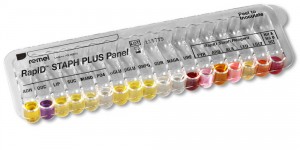Oxoid Provides Food Testing Labs with Simple Remel RapID Range of Biochemical Identification Panels
- Like
- Digg
- Del
- Tumblr
- VKontakte
- Buffer
- Love This
- Odnoklassniki
- Meneame
- Blogger
- Amazon
- Yahoo Mail
- Gmail
- AOL
- Newsvine
- HackerNews
- Evernote
- MySpace
- Mail.ru
- Viadeo
- Line
- Comments
- Yummly
- SMS
- Viber
- Telegram
- Subscribe
- Skype
- Facebook Messenger
- Kakao
- LiveJournal
- Yammer
- Edgar
- Fintel
- Mix
- Instapaper
- Copy Link
Posted: 28 May 2010 | Oxoid | No comments yet
Oxoid today announced that the Remel RapID™ microbial identification systems are now available alongside the Oxoid range.
Oxoid today announced that the Remel RapID™ microbial identification systems are now available alongside the Oxoid range.
Oxoid, a world leading microbiology brand, today announced that the Remel RapID™ microbial identification systems are now available alongside the Oxoid range. The one-step inoculation procedure of RapID makes it the easiest ID system on the market to use. And results are available in just four hours, making it the fastest and most convenient ID system in its class, with the potential to save time, labour and money (ref 1).


Simple Remel RapID Range of Biochemical Identification Panels
Unlike alternative methods that require separate inoculation of individual wells, RapID identification panels have a simple, one-step inoculation procedure. A suspect colony suspension is simply added to the inoculation tray and tipped into the test strip, inoculating each well simultaneously. Furthermore, each RapID panel uses the same simple procedure, so if you can use one panel, you can use them all.
RapID systems provide rapid, same-day results (refs 1,2,3), unlike some alternative methods that require 18-72 hours. This is because RapID detects preformed bacterial enzymes and is not dependent on the growth of the organism (ref 4). This feature allows the panels to be incubated aerobically without the need for oil overlays – resulting in savings in time and resources. Panels require no specialized automation, so even small microbiology laboratories can easily adopt RapID (ref 2).
In trials, the RapID method demonstrated excellent performance in the identification of oxidase negative Enterobacteriaceae (ref 5) , anaerobic bacteria (ref 4) , Gram-negative glucose non-fermenters (refs 2,3,6) and yeasts and related organisms (refs 1,7) and streptococci and related organisms (refs 8,9). A new system is now available for the identification of staphylococci and related organisms.
Distinct colour reactions make RapID easy to read and interpret. Accurate identifications are obtained from the user-friendly, Windows®-based ERIC® software, with results ranked by probability.
Cheryl Mooney, industrial applications manager, Oxoid, comments, “The ability to ensure product safety while keeping costs to a minimum is crucial to the food industry in the current financial climate. RapID allows the microbiology laboratory to confirm microbial identifications on isolates from raw materials, finished product or the production environment speedily, thus avoiding delays in production or release of product, which saves time and money.”
For further information, contact Oxoid: tel +44 1256 841144, fax +44 1256 329728, email [email protected] or visit www.oxoid.com.
References
- Kitch, T.T., Jacobs, M.R., McGinnis M.R. and Appelbaum, P.C. (1996) J.C.M. 34(5):1069-1071
- Kitch, T.T, Jacobs, M.R. and Appelbaum, P.C. (1992) J.C.M. 30(5):1267-1270
- Vossler, J. and Roberts, D. (1993) ICAAC Abstract.
- Marler, L.M., Siders, J.A., Wolters, L.C. et al (1991) J.C.M. 29(3): 874-878
- Kitch, T.T., Jacobs, M.R. and Appelbaum, P.C. (1994) J.C.M. 32(4):931-934
- Kiska, D.L., Kerr, A., Jones, M.C. et al (1996) J.C.M. 34(4): 886-891
- Wadlin, J.K., Hanko, G., Stewart, R. et al (1999) J.C.M. 37(6) 1967-1970
- Arduino, M.J., McAllister, S.K., Shey, D.K. et al (1994) 94th ASM General Meeting Abstract C-138
- You, M.S. and Facklam, R.R. (1986) J.C.M. 24(4): 607-611
Oxoid is part of Thermo Fisher Scientific Inc., the world leader in serving science.




